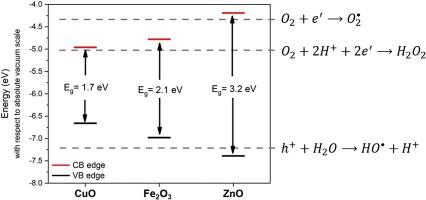当前位置:
X-MOL 学术
›
Colloids Surf. A Physicochem. Eng. Aspects
›
论文详情
Our official English website, www.x-mol.net, welcomes your
feedback! (Note: you will need to create a separate account there.)
CuO Enhances the Photocatalytic Activity of Fe2O3 through Synergistic Reactive Oxygen Species Interactions
Colloids and Surfaces A: Physicochemical and Engineering Aspects ( IF 4.9 ) Pub Date : 2020-10-01 , DOI: 10.1016/j.colsurfa.2020.125179 Emily Asenath-Smith , Emma K. Ambrogi , Eftihia Barnes , Jonathon A. Brame
Colloids and Surfaces A: Physicochemical and Engineering Aspects ( IF 4.9 ) Pub Date : 2020-10-01 , DOI: 10.1016/j.colsurfa.2020.125179 Emily Asenath-Smith , Emma K. Ambrogi , Eftihia Barnes , Jonathon A. Brame

|
Abstract Iron oxide (α-Fe2O3, hematite) colloids were synthesized under hydrothermal conditions and investigated as catalysts for the photodegradation of an organic dye under broad-spectrum illumination. To enhance photocatalytic performance, Fe2O3 was combined with other transition-metal oxide (TMO) colloids (e.g., CuO and ZnO), which are sensitive to different regions of the solar spectrum (far visible and ultraviolet, respectively), using a ternary blending approach for compositional mixtures. For a variety of ZnO/Fe2O3/CuO mole ratios, the pseudo-first-order rate constant for methyl orange degradation was at least double the sum of the individual Fe2O3 and CuO rate constants, indicating there is an underlying synergy governing the photocatalysis reaction with these combinations of TMOs. A full compositional study was carried out to map the interactions between the three TMOs. Additional experiments probed the identity and role of reactive oxygen species and elucidated the mechanism by which CuO enhanced Fe2O3 photodegradation while ZnO did not. The increased photocatalytic performance of Fe2O3 in the presence of CuO was associated with hydroxyl radical ROS, consistent with heterogeneous photo-Fenton mechanisms, which are not accessible by ZnO. These results imply that low-cost photocatalytic materials can be engineered for high performance under solar illumination by selective pairing of TMOs with compatible ROS.
中文翻译:

CuO 通过协同活性氧物种相互作用增强 Fe2O3 的光催化活性
摘要 在水热条件下合成了氧化铁(α-Fe2O3,赤铁矿)胶体,并研究了其作为有机染料在广谱光照下光降解的催化剂。为了提高光催化性能,Fe2O3 与其他对太阳光谱的不同区域(分别为远可见光和紫外线)敏感的过渡金属氧化物 (TMO) 胶体(例如 CuO 和 ZnO)结合使用三元混合方法对于成分混合物。对于各种 ZnO/Fe2O3/CuO 摩尔比,甲基橙降解的准一级速率常数至少是单个 Fe2O3 和 CuO 速率常数之和的两倍,表明存在潜在的协同作用,控制与这些 TMO 的组合。进行了完整的成分研究以绘制三种 TMO 之间的相互作用。其他实验探讨了活性氧的特性和作用,并阐明了 CuO 增强 Fe2O3 光降解而 ZnO 没有的机制。在 CuO 存在下 Fe2O3 光催化性能的提高与羟基自由基 ROS 相关,这与 ZnO 无法达到的异质光芬顿机制一致。这些结果表明,通过将 TMO 与兼容的 ROS 选择性配对,可以将低成本光催化材料设计为在太阳光下具有高性能。在 CuO 存在下 Fe2O3 光催化性能的提高与羟基自由基 ROS 相关,这与 ZnO 无法达到的异质光芬顿机制一致。这些结果表明,通过将 TMO 与兼容的 ROS 选择性配对,可以将低成本光催化材料设计为在太阳光下具有高性能。在 CuO 存在下 Fe2O3 光催化性能的提高与羟基自由基 ROS 相关,这与 ZnO 无法达到的异质光芬顿机制一致。这些结果表明,通过将 TMO 与兼容的 ROS 选择性配对,可以将低成本光催化材料设计为在太阳光下具有高性能。
更新日期:2020-10-01
中文翻译:

CuO 通过协同活性氧物种相互作用增强 Fe2O3 的光催化活性
摘要 在水热条件下合成了氧化铁(α-Fe2O3,赤铁矿)胶体,并研究了其作为有机染料在广谱光照下光降解的催化剂。为了提高光催化性能,Fe2O3 与其他对太阳光谱的不同区域(分别为远可见光和紫外线)敏感的过渡金属氧化物 (TMO) 胶体(例如 CuO 和 ZnO)结合使用三元混合方法对于成分混合物。对于各种 ZnO/Fe2O3/CuO 摩尔比,甲基橙降解的准一级速率常数至少是单个 Fe2O3 和 CuO 速率常数之和的两倍,表明存在潜在的协同作用,控制与这些 TMO 的组合。进行了完整的成分研究以绘制三种 TMO 之间的相互作用。其他实验探讨了活性氧的特性和作用,并阐明了 CuO 增强 Fe2O3 光降解而 ZnO 没有的机制。在 CuO 存在下 Fe2O3 光催化性能的提高与羟基自由基 ROS 相关,这与 ZnO 无法达到的异质光芬顿机制一致。这些结果表明,通过将 TMO 与兼容的 ROS 选择性配对,可以将低成本光催化材料设计为在太阳光下具有高性能。在 CuO 存在下 Fe2O3 光催化性能的提高与羟基自由基 ROS 相关,这与 ZnO 无法达到的异质光芬顿机制一致。这些结果表明,通过将 TMO 与兼容的 ROS 选择性配对,可以将低成本光催化材料设计为在太阳光下具有高性能。在 CuO 存在下 Fe2O3 光催化性能的提高与羟基自由基 ROS 相关,这与 ZnO 无法达到的异质光芬顿机制一致。这些结果表明,通过将 TMO 与兼容的 ROS 选择性配对,可以将低成本光催化材料设计为在太阳光下具有高性能。











































 京公网安备 11010802027423号
京公网安备 11010802027423号